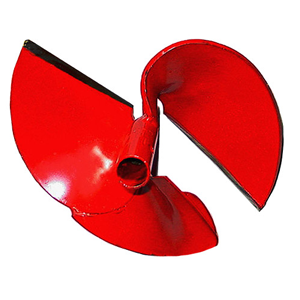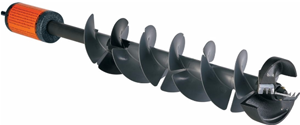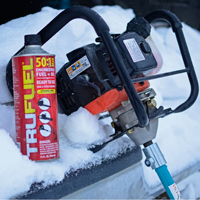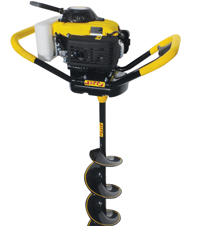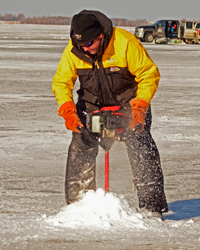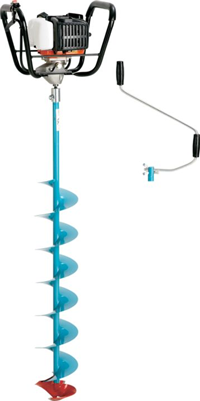Fishrapper Fishing Articles Section: Auger Wars? Nope, Just Drilling For Answers! Jeff Sundin
Ice Auger Update Feb. 16, 2017 Original Article Auger Wars It’s been a while since I updated the Auger Wars story and since there have been a few new developments lately, I think this is a good time to do it. |
|
Conversely, my experience with the ION auger was not as good. Yes, it does drill a hole, but from my point of view, it was much slower, I could drill 3 holes with my auger before the ION punched through the first one. Now maybe the owner hadn’t kept the blades sharp, and maybe some units are better than others. But I don’t see how I could ever be happy using the one that we had in our hands; it just wouldn’t work for me.
Another important comparison is the cost of batteries. No matter which electric you use, you’re going to need a couple of spare batteries. I did a search on Amazon where you can go with the ION Battery at $140.00 each, or you could choose a De Walt 18 Volt battery for $50.00, maybe less.
I don’t know how much easier a choice could be. In my mind, the K-Drill gets the nod over the ION any day of the week.
By the way, the K-Drill isn’t the only game in town. There are other units that allow you to convert your ½ inch cordless drill into an ice auger. In my case, Nils has me covered again; their $45 conversion will allow me to convert my auger into an electric whenever I need it.
Ice Auger Update Feb. 12, 2015 - If you followed the original article, "Auger Wars" (see below) about my search for an ice auger; one that I could rely as the perfect tool for my style of fishing, then you remember that I promised an update. So after a couple of month on the ice, living with my own decision, here's a look at how the facts "Drill Down".
One other auger that caught my attention this winter is Jiffy’s 4G, model 41. It’s a 4-stroke engine that runs on plain, un-mixed gas and it seems to be better at shrugging off cold weather than the LP Gas 4 stroke. |
|
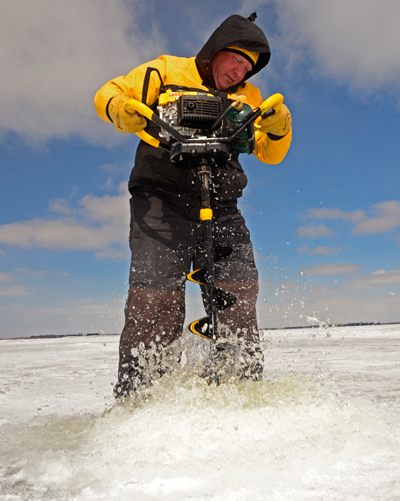 |
Auger Wars? NOPE! Just Drilling For Answers Dave Peterson wrote; Hey Jeff, I'm looking for your opinion on buying a new ice auger. I'm 67, in pretty good shape, spear 60-70 % of my winter fishing and I'm due for a good new ice auger. Gas vs Battery? 8" vs 10"? Good model and brand of each? |
Luckily, every manufacturer has some tried and true models, machines that have been around for a while and have a proven track record. I believe that there are plenty of good ones out there and you'll have the opportunity to make some good choices. So the real effort lays in "Drilling Down" the list of options. |
|
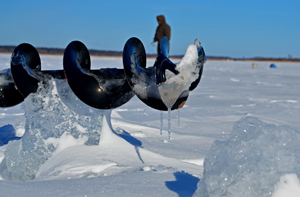 When the going gets tough, some augers quit going. We found that severe cold temperatures worked against our 4 Stroke models, idling them just when we needed them most. Sundin says; "2 Stroke Gas Auger engines are still the most widely available and because I spend most of my time fishing outside using a portable shelter, the smoke from a 2 stroke isn't a problem for me". |
For us, really cold conditions have caused these units to lose power, slowing down the drilling time. Occasionally they will not idle properly and sometimes we've seen them fail to run until we can get them warmed up again. Whenever they do warm back up, they have always worked fine again. So, if you can avoid the coldest days, this one could be for you. By the way, the chipper style blades found on Jiffy's models are good for re-opening existing holes too and carrying extra 1 pound LP cylinders is convenient. Much more so than carrying spare gasoline or expensive batteries. At 28 lbs., the 8 inch model is a little heavier than I'd like, especially during early ice when I'm on foot. But some folks swear that the added weight equals extra strength and durability. 2 Stroke Gas Auger engines are still the most widely available and because I spend most of my time fishing outside using a portable shelter, the smoke from a 2 stroke doesn't bother me. So until I see an alternative that really kicks ... I am going to stick with the proven reliability of the 2 stroke, that's still the best option for the way I fish. You'll notice that I don't list every single make and model of auger. That's because while I was doing my own research, I already paired the list down to the ones that I believe would best serve my needs. If you don't see your favorite model, it doesn't mean that I didn't look at it. So, here's the way it breaks down for me. Drum Roll Please ... |
| 3rd Runner Up - Strikemaster's Lazer Mag has been around for a long time. In fact, I still have one that I've been using for several years and it's going to continue serving as my backup. It's already been delivered to the shop where they are going to give it a full tune up and re-build the carburetor. I like the Lazer style blades because they drill holes fast and I like the light weight too. At 25 pounds, this is one of the easier units to carry on the ice. Overall, I've been well satisfied with mine and if you chose one, you wouldn't get any argument out of me. 2nd Runner Up - Jiffy's 4G Lite Ice Auger really got me thinking. On paper, it looks really interesting. At 26 lbs., the weight isn't horrible and Jiffy's 2-2-2 warranty (two-year engine, transmission and STX blades warranty) is really attractive too. But after the experiences we had with 4 stroke augers last winter, I'm going to wait until I have a chance to see that the bugs are worked out. I have used this one myself and most of the time it was great. Still, there were those days, the really cold ones that we had to fish whether we wanted to or not. Most folks don't fish on days like that and for them, these augers could be ideal. They have a loyal following already and I'm sure that I'll cross paths with a couple of them this winter. When I do, I'm going to pay a lot of attention. 1st Runner Up - Eskimo's Shark 51.7cc Ice Auger happens to be the auger that kept us going on Devils Lake last winter when the others failed. It has features that I really like and I cannot find anyone who has complained about reliability. Most everyone agrees that the Eskimo is a work horse and it's another good choice for any application where weight wasn't a consideration. I could easily have chosen this auger for myself. But at 32 pounds, this one is just too heavy for me. If the added weight isn't a problem for you, then I suggest that you take a close look at this one. My Winner - The Nils USA Power Auger has achieved a fantastic reputation among it's cult followers. Their fans are intensely loyal and every Nils auger owner that I have talked to raves about them. Remember the old saying; "If you can't dazzle them with brilliance, baffle them with b......t! Well, Nils haven't spent a ton of money on brilliant marketing campaigns and that's why you may not have learned about them yet. But if grass roots, word of mouth advertising impresses you, then you will eventually become impressed. At first glance, they appear to be a little clunky; industrial looking. But an auger doesn't have to be pretty, I don't want to marry an ice auger, I just want to drill holes with it. For me, an auger that works when it's supposed to is a lot more than pretty, it's beautiful! Nils offers interchangeable everything. The power head can be purchased alone or combined with a 4-1/2", 6" or 8" blade. You can remove the power head and replace it with a hand crank to convert your power auger into a hand auger. For Trout fishermen who visit "non-motorized" waters, or for anglers who like to hoof it to early season spots, that's a nice feature. By the way, Nils already enjoys a great reputation for hand augers and Nils owners are fiercely loyal about their "power by arm-strong" models too. Rigged up with the 6" drill, the weight is only 20 pounds and with the 8" drill weighs in at 22 pounds. That makes this one the lightest weight power auger that I can find. When I order it, I will heed the advice of anglers who have warned me to get an extra set of blades. That's because in the event that I dull mine prematurely, it's unlikely that I'll be able to walk into the bait shop for a quick replacement. At $619.00, it's definitely going to chew up a big chunk of my ice fishing budget. But if it lives up to its reputation, it's going to be a money saver in the long run. For the weekend warrior, this one could be a no-brainer because of Nils 7 year, consumer warranty. Seven years is a lot of time to warranty anything and it tells me something about the faith that they have in this auger. Even pros who are usually excluded from warranty get 2 years and that's really attractive to me too. |
|
 |
Helping your fellow fishermen and women stay abreast of the fishing conditions in your area is good for everyone and it's easier than you think! |
The Fishrapper, Fishing Blue Books, LLC • 715 Byington Ave • La Prairie, MN 55744 • 218-245-9858
copyright©2023 Fishing Blue Books, LLC All Rights Reserved - last revised 07/16/2023
Current Fishing Reports • Guided Fishing Trips • Current Video • Fishing Articles • Fishing Links • Contact
